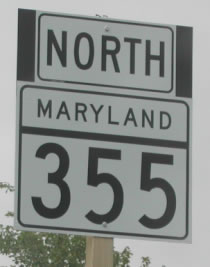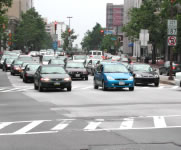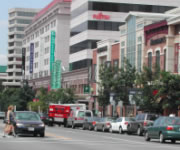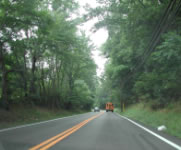Planning Process: Why, What, and Issues
355/270 Technology Corridor Study
 |
 |
 |
 |
Planning Program
The planning program for the I-270 Corridor over the next five years provides a unique opportunity to improve the physical environment of the corridor by creating a dynamic system of vibrant transit-oriented centers connected together by an integrated system of streets, and a comprehensive transit system. Linking land use and transportation provides new opportunities to connect live, work, and play within the I-270 Corridor. Quality of life issues include the need for transportation options, ample entertainment, recreation facilities, hotels and meeting spaces, parks, and open spaces within the I-270 Corridor.
Why
Nearly 40 years ago, Montgomery County’s General Plan created the concept of “Wedges and Corridors,” an enduring regional land use plan that envisioned growth corridors radiating out from Washington D.C. like spokes of a wheel that were separated by green wedges of open space, farmland, and lower density residential uses. For more information about the General Plan, click here. The corridors provide opportunities for compact, transit serviceable growth while the Wedges provide respite, recreation, and protection of natural resources. This pattern will continue to shape the County’s development by channeling growth in an Urban Ring around Washington D.C. and in the I-270 Corridor.
The I-270 Corridor plays a significant role in Montgomery County’s future, and is recognized as a major center for biotechnology employment in the United States. The biotechnology, and advanced information and telecommunication industries in the region has grown out of federal government spending and regulations, and innovative research by the National Institutes of Health (NIH). These rapidly growing industries have many synergistic facets that form a complex web of interconnections among federal labs, local universities, and local and worldwide firms that are driving development in Montgomery County’s I-270 Corridor.
Attracting “tech” companies in a competitive world market is a primary thrust of the County’s economic development strategy. Attracting these employers rests on proximity to the region’s internationally recognized research and educational institutions, and providing the quality of life features expected by workers of this industry. In order to support these industries, suitable locations for businesses that provide support services and housing for a variety of income levels are needed to address the opportunities and obstacles that come with this economic force.
What
The 355/270 study
This Study spans the agency’s master plan boundaries (Bethesda/Chevy Chase/North Bethesda, I-270 Corridor, and Rural Areas West and East). It examines the area in its entirety and focuses most specifically on MD 355 and I-270. This study analyzes the corridor from four perspectives: Work, Life, Health, and Access:
- Work
This section identifies the economic forces that are shaping our economy today and focuses on the basic economic forces that will likely shape the County’s economy in the future. - Life
This section identifies the quality of life features that should be considered in the development of sector plans and master plans for making Montgomery County communities desirable places to live and work - Health
This section addresses the environmental planning. - Access
This section provides a look at our existing transportation systems, and discusses how it might function in the future.
The amount and pace of development will be included in the Growth Management Initiative.
This study will coordinate the MD 355/I-270 plans (Shady Grove, Twinbrook, White Flint, Gaithersburg Vicinity West of I-270, and Germantown master plans). The first phase of our work was to develop information concerning the Corridor’s existing conditions including an inventory and analysis of: demographics, land use and zoning, transportation systems, environmental systems, the school system, and public facilities. Opportunities and constraints were also identified. For more detailed information on the data collected click here. This phase of work will be presented to the Planning Board in mid September 2007. Additional deliverable dates for the 355/270 Study will occur in conjunction with the following master plans and sector plans:
- Gaithersburg Vicinity West of I-270 Master Plan
- Germantown Master Plan
- Twinbrook
- White Flint Sector Plan
Community comments and issues
Identification of issues has already begun through the Centers and Boulevards project. Click here for more information on this effort and in preparing work programs for the first phase of data collection. Listed below is a summary of the information gathered from the community to date.
Learn more about how to participate in the planning process.
- Engage in a holistic approach to planning the corridor. Consider the cumulative impact of growth within the corridor when making decisions about the environment, housing, transportation, visual quality, and community issues. Foster multi-agency/institution/governmental coordination to ensure implementation. Establish indicators to measure success.
- Each section of the corridor has its own unique character – there is a potential to develop distinctive approaches to each segment while being mindful of the need for a unifying theme, for example: give MD 355 a single name, highlighting the historical aspects of the road with an educational trail system, and transitioning between communities. Keep Montgomery County in a bio-technology leadership position.
- Create a better balance of jobs and housing by establishing a diversity of mixed-use centers that become the focus of community life. Protect new and old communities by retaining the community culture of older areas, and preserving existing green space. Provide job and business opportunities, including retail and services uses in the Up-county segments of MD 355. Address affordable housing in the corridor, and accommodate families by providing adequate school capacity.
- Improve the visual characteristics and urban design features along the corridor by highlighting and punctuating MD 355’s important nodes and gateways. Green the corridor with trees, and transform MD 355 into a boulevard with streetscape, parks, and green space. Provide civic uses and gathering spaces for recreation and passive relaxation. Scale new development to be compatible with the existing built environment. Build closer to the street with ground floor activity to create more vibrant street-life.
- Plan for adequate transportation - develop more bikeways and trails accessible to MD 355, and provide mass transit opportunities in the median. Provide a local shuttle to shopping and Metro stations areas.
- Take back the road for pedestrians - provide pedestrian connectivity and improve pedestrian safety. Increase pedestrian connections with crosswalks, underpasses, and overpasses. Improve connections to the park system.
- Ensure implementation by creating new zones, amending master plans, and instituting management mechanisms such as the National Trust for Historic Preservation’s Mainstreet Program or a redevelopment corporation. Streetscapes should be funded, managed and maintained.
Date of last update: July 25, 2007